Chittorgarh
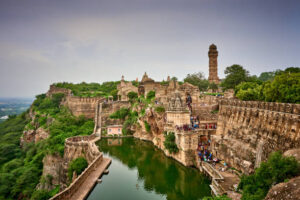
Chittorgarh Fort, the largest fort in India, stands as a testament to Rajput bravery, sacrifice, and resilience. Located in Rajasthan, this UNESCO World Heritage Site covers 700 acres and houses grand palaces, temples, and towering gateways. Built in the 7th century by the Mauryas, it later became the capital of Mewar.
The fort has witnessed legendary battles, including Alauddin Khilji’s siege in 1303 and Emperor Akbar’s attack in 1568. Stories of Rani Padmini’s jauhar (self-immolation) and Maharana Pratap’s resistance add to its historical significance. Key attractions include the Vijay Stambh (Victory Tower), Kirti Stambh, Rana Kumbha Palace, and the serene Gaumukh Reservoir.
Chittorgarh Fort remains a symbol of Rajputana pride, drawing history lovers and tourists alike. Its majestic ruins, intricate carvings, and rich past make it an unmissable destination for those eager to explore India’s glorious heritage.
History of Chittorgarh Fort
Chittorgarh Fort has a history that dates back to the 7th century when it was originally built by the Mauryan rulers. Later, it became the capital of the Mewar Kingdom under the rule of the Guhila dynasty and subsequently the Sisodia Rajputs. The fort remained a symbol of Rajput courage, witnessing numerous battles, conquests, and acts of heroism over the centuries.
The most notable sieges of Chittorgarh Fort include:
- Alauddin Khilji’s Siege (1303): The Sultan of Delhi, Alauddin Khilji, invaded Chittorgarh with the intent of capturing Rani Padmini, famed for her beauty. When defeat seemed inevitable, Rani Padmini, along with thousands of Rajput women, performed jauhar (self-immolation) to protect their honor, while the Rajput warriors fought to the death.
- Bahadur Shah’s Attack (1535): Bahadur Shah of Gujarat launched a brutal assault on the fort, leading to another jauhar, this time by Rani Karnavati and many other women of Chittorgarh.
- Emperor Akbar’s Conquest (1568): Mughal Emperor Akbar besieged the fort with a massive army, leading to fierce resistance by the Rajputs under Maharana Udai Singh II. However, the fort fell after a prolonged battle, resulting in yet another mass jauhar and the eventual abandonment of Chittorgarh as the capital.
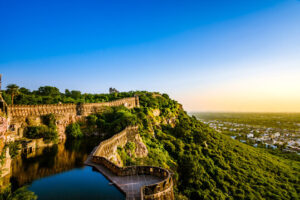
Despite these repeated invasions, Chittorgarh remained a stronghold of Rajput power and resilience. After the fall of the fort to the Mughals, the Sisodia rulers moved their capital to Udaipur. However, Chittorgarh Fort continued to hold immense historical and cultural significance, standing as a proud testament to the undying spirit of Rajput warriors.
The fort’s history is also intertwined with great Rajput heroes such as Maharana Pratap, who refused to submit to the Mughals and continued his fight for Rajputana independence. His legacy adds to the fort’s enduring reputation as a symbol of resistance and bravery.
Today, Chittorgarh Fort stands as a proud relic of Rajputana’s glorious past, attracting visitors from around the world who come to witness its grandeur, learn about its legendary tales, and pay homage to the sacrifices made within its walls.
Architectural Grandeur
Chittorgarh Fort is a fine example of Rajput architecture, featuring grand palaces, intricate temples, towering gates, and vast reservoirs. Some of the key structures inside the fort include:
- Vijay Stambh (Victory Tower): Built by Maharana Kumbha in 1448 to celebrate his victory over Mahmud Khilji, this 9-story tower is adorned with intricate carvings and inscriptions.
- Kirti Stambh (Tower of Fame): A 12th-century Jain monument dedicated to Adinath, the first Jain Tirthankara.
- Rana Kumbha Palace: The ruined palace of Maharana Kumbha, believed to be the place where Rani Padmini performed jauhar.
- Padmini’s Palace: A three-story white palace surrounded by water, associated with Rani Padmini’s beauty and the reason for Alauddin Khilji’s invasion.
- Meera Temple: Dedicated to the famous devotee-saint Meera Bai, this temple reflects the rich religious culture of the Rajputs.
- Gaumukh Reservoir: A perennial water source considered sacred, where water flows continuously from a cow-shaped mouth into the reservoir below.
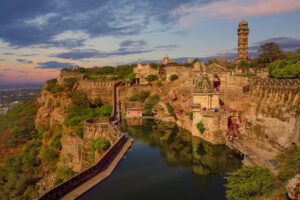
Legends and Folklore
Chittorgarh Fort is steeped in legends, with the most famous being the story of Rani Padmini. According to folklore, Alauddin Khilji was captivated by her beauty and laid siege to the fort to possess her. To protect her honor, she and thousands of Rajput women committed jauhar. This event remains a powerful symbol of Rajputana honor and sacrifice, making Chittorgarh synonymous with valiant defiance.
Another legend associated with the fort is of Meera Bai, the Rajput princess and poet-saint who renounced her royal life to devote herself to Lord Krishna. Despite opposition from her in-laws, she continued her devotional singing and poetry, eventually leaving Chittorgarh for Dwarka. Her temple within the fort attracts devotees from across India, keeping her legacy alive.
A lesser-known legend speaks of Bappa Rawal, the founder of the Mewar dynasty, who is believed to have received divine blessings from a sage near the fort. It is said that the fort was given to him as a boon, making him one of the most revered rulers in Rajput history.
The fort is also associated with mystical tales of spirits and hidden treasures. Many locals believe that on certain nights, echoes of war cries and whispers of ancient warriors can still be heard in the fort’s ruins, adding an air of mystery to its already captivating history.
Why Visit Chittorgarh Fort?
Chittorgarh Fort is more than just a historic site; it is a living testament to the courage and cultural richness of Rajasthan. Visitors can explore its massive gates, beautiful temples, and stunning views of the surrounding landscape. The annual Jauhar Mela, held to honor the sacrifices of Rajput warriors and women, is a significant event that attracts thousands of visitors.
Best Time to Visit & Travel Tips
- Best Time to Visit: October to March, when the weather is pleasant.
- How to Reach: The nearest airport is in Udaipur (90 km away), and the fort is well-connected by rail and road.
- Entry Fee: ₹50 for Indians, ₹600 for foreign tourists.
- Timings: 9:00 AM to 6:00 PM.
- Tips: Wear comfortable shoes, carry water, and hire a local guide for the best experience.
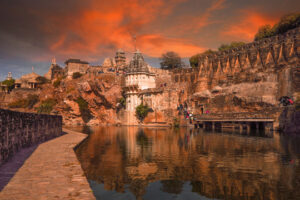
Conclusion
Chittorgarh Fort stands as an eternal symbol of Rajput pride, sacrifice, and resilience. It is not merely a historical monument but a living embodiment of the glorious past of Rajasthan. The fort’s impressive architecture, intricate carvings, and awe-inspiring structures take visitors on a journey back in time, allowing them to relive the courage and heroism of the Rajputs.
A visit to Chittorgarh Fort is more than just sightseeing; it is an opportunity to connect with India’s rich heritage and the undying spirit of its warriors. The stories of Rani Padmini’s sacrifice, Maharana Pratap’s valiant struggles, and the grandeur of Mewar’s rulers continue to inspire generations.
Walking through its towering gates, exploring its majestic palaces, and witnessing the breathtaking views from its high walls provide an unforgettable experience. Whether you are a history enthusiast, architecture lover, or cultural explorer, Chittorgarh Fort promises a journey filled with awe, admiration, and deep respect for the Rajputana legacy. Its timeless ruins, compelling stories, and mesmerizing landscape make it one of India’s most significant and must-visit heritage sites.
Chittorgarh Map
Follow More Article

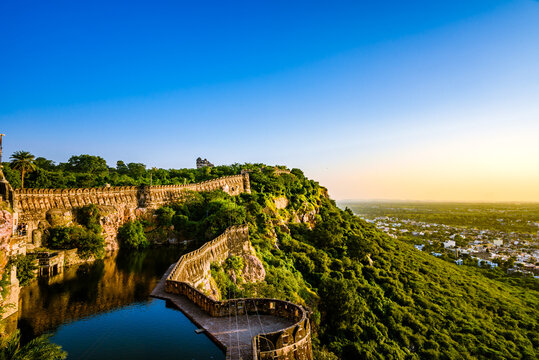





Recent Comments